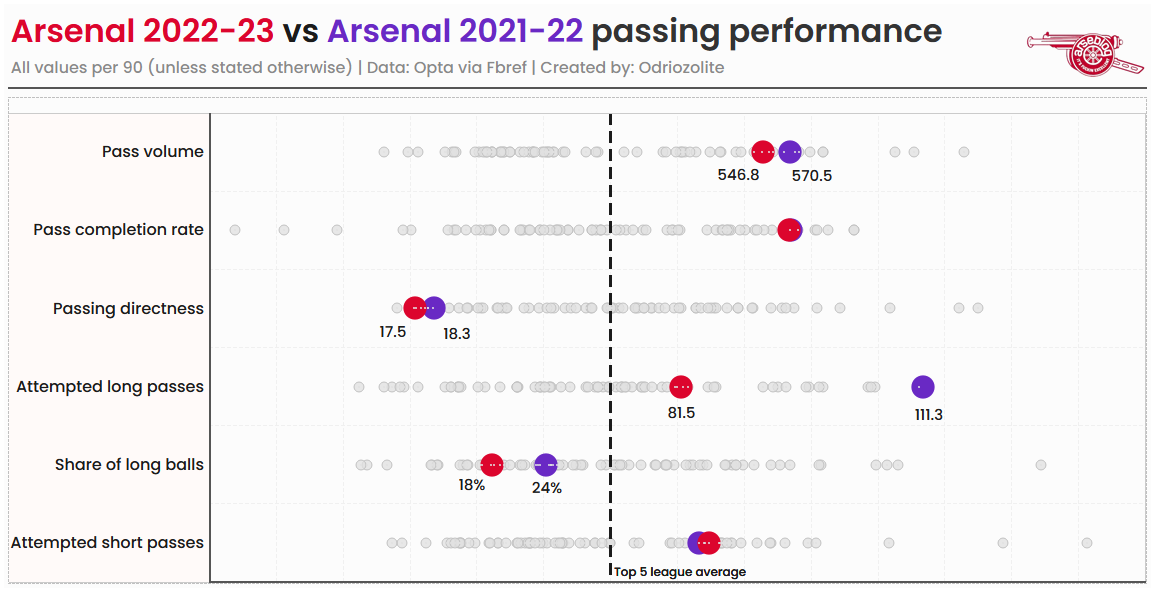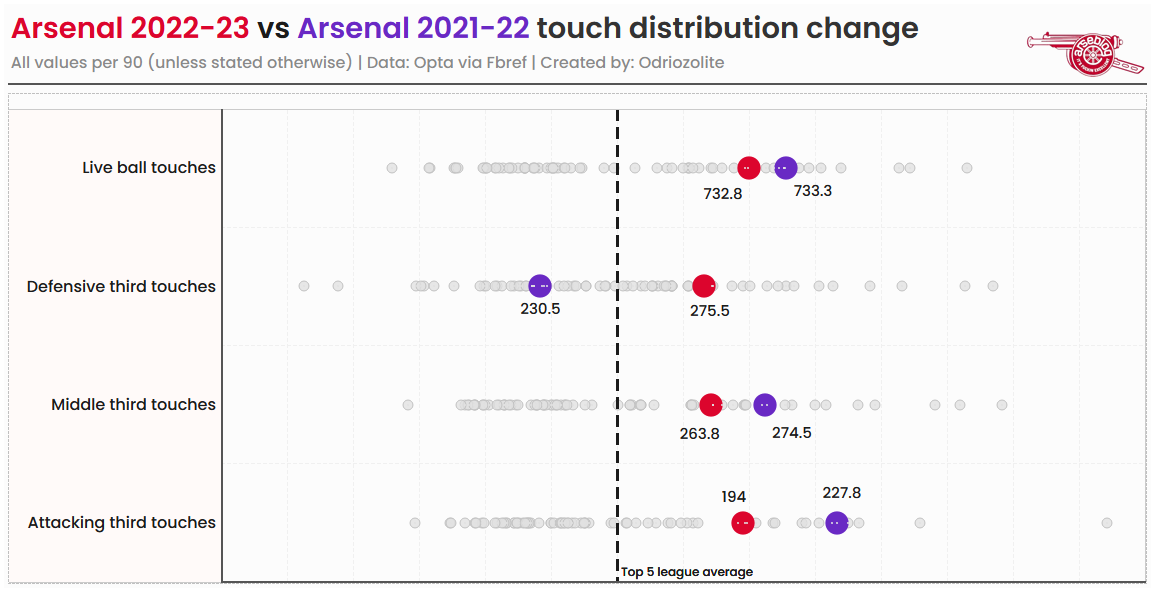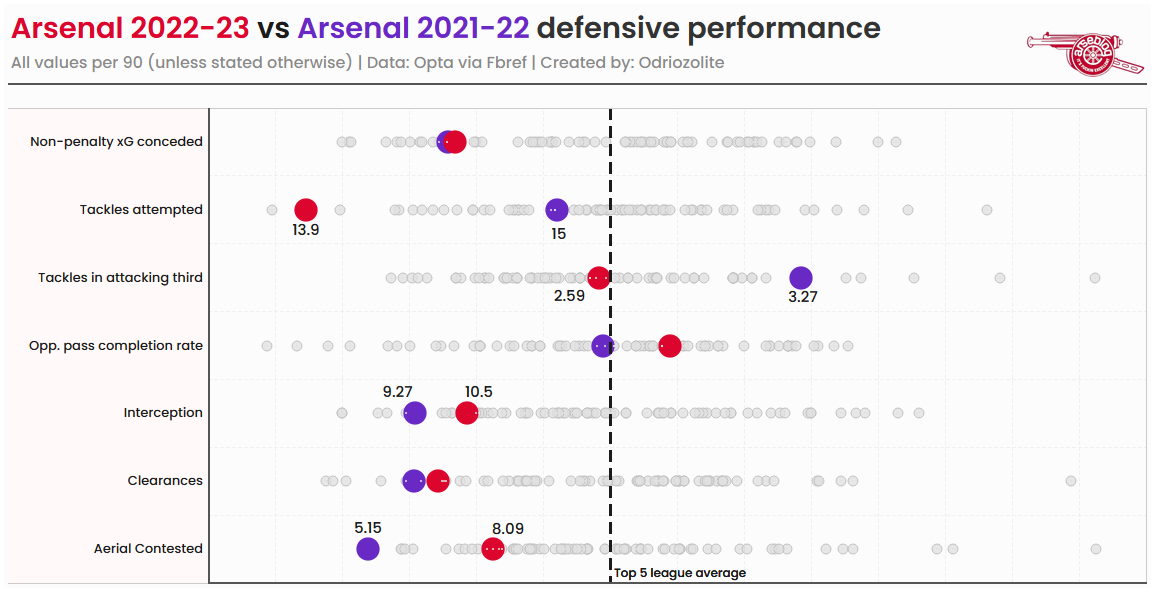Arsenal Women’s 2022-23 season was shaped by the injuries they suffered. Even prior to the four ACL injuries they suffered, the Gunners lost first-choice centre-half pairing Leah Williamson and Rafaelle. Essentially, after their second WSL game of the season at home to Spurs, they were heavily depleted for every game thereafter.
It meant that Jonas Eidevall and his team had to adapt, they had to build a new defence in the autumn with Steph Catley switching to centre-half. Then they had to build a new attack without Mead and Miedema and then when Kim Little and Leah Williamson were injured for the run-in, he switched the formation entirely. Clearly, that shows up in the data this season compared to last, so let’s run some numbers (all courtesy of FBRef and all WSL only).
The attack
The first thing to say is that Arsenal scored far fewer goals this season than they did last season. A lot of that can be explained by the loss of Mead and Miedema in the winter, who either scored or assisted 66% of Arsenal’s WSL goals in 2021-22. Few teams could endure that sort of loss without it showing up in the GA column. Here are the pertinent attacking numbers.

Arsenal scored 15 fewer goals in the WSL despite creating a higher XG than 2021-22 and despite landing a greater number of their shots on target (with a lower average shot distance too). There’s not an awful lot to analyse here other than to say the loss of Mead and Miedema hurt Arsenal’s efficiency in front of goal even if chance creation was relatively unaffected.
Mead’s last 28 WSL goals have come from an XG of 17.8, Miedema’s last 74 WSL goals have come from an XG of 52.1. Arsenal lost two serial overperformers when it comes to finishing. The positive is that chance creation did not suffer too much, they had 385 shots in the WSL this season compared to 402 in 2021-22, albeit they landed a greater percentage of shots on target during this campaign.
Frida Maanum filled in nicely for Vivianne Miedema, her nine goals and four assists in the WSL are very respectable numbers. Mead’s absence was a bigger issue for Arsenal simply because they don’t have ana analogue for Mead’s qualities. Eidevall changed things up on the right, using either Katie McCabe or Victoria Pelova as more of a ‘right 10’, which led to a shift in emphasis. Pelova and McCabe enjoyed excellent second halves of the season and helped Arsenal to shift to a new style but, ultimately, few right wingers in the world put up the kind of goal and assist numbers Mead manages.
Possession

We can see from the possession data that Arsenal became more patient with the ball this season and, again, that was likely defined by absences to key players in their build-up. They had less possession per game compared to 2021-22 with an almost identical completion rate. However, we can see how the absence of Leah Williamson impacted the numbers.
Arsenal made far fewer long passes and, in reality, long passes almost always emanate from your defenders. Even though Lotte Wubben-Moy has a mighty whack on her and one she used often to try to find Blackstenius in the right channel, Eidevall’s side used that weapon more sparingly. The data takes on an even more Williamson shaped hole when you dig a little deeper and look at the drop off in switches of play (defined as a pass that travels more than 40 yards across field) and progressive passes (defined as a pass that takes you at least ten yards closer to the opponent’s goal).

Arsenal had to change the way they built from the back but, not only that, without Mead on the right-wing and with more of a ‘right ten’ in Pelova and McCabe, that demands a more intricate approach. Mead is a very direct player, as Jonas Eidevall told me earlier in the season, “I worked out quickly you just leave her on her own.”
Pelova and McCabe, as tens, are more drawn to the ball and the build-up, whereas Mead wants the ball out wide and on the lip of the penalty area. All of this led to a more considered approach. Arsenal also attempted far more through balls this season, jumping from 0.14 per 90 last season to 0.68 per 90 this season. Much of this is also due to the sustained presence of Stina Blackstenius upfront.

We see from this data that Arsenal have roughly the same amount of touches of the ball but a higher percentage of the touches are in their own defensive third and a lower percentage happen in the final third which, again, speaks to a slightly less direct approach defined by the absences of Williamson and Mead. Without Williamson the ball travels forward slightly more slowly and with McCabe or Pelova floating as right tens, they come towards the ball to receive short passes.
However, one significant attacking change this season has been the number of take-ons that Arsenal attempt. Here they have jumped from 7.59 take-ons per 90 last season to 14.5 this season, almost doubling last season’s total. A lot of this is explained by the replacement of Miedema with Maanum. It’s not a perfect comparison given Miedema moved to the 10 role in February 2022 but last season and this season she averaged 1.4 take ons per 90.
Maanum averaged more than double that (3.00). Still, with Mead out and Rafaelle missing a lot of the season, it is surprising that the number of take-ons has risen and that is also probably a symptom of the team becoming more familiar with Eidevall’s demands. He wants players like Caitlin Foord, Frida Maanum and Pelova to drive at opposition players, he wants attackers that make high risk / high reward actions that force opponents to make decisions.
Discipline and duels
Eidevall wants a counterpressing style to ally with a team that takes risks in possession. Last season, this shift in emphasis away from Joe Montemurro’s more patient possession style led to some looseness which resulted in a greater number of fouls and yellow cards. The severity of the fouls has dropped even if the number of fouls committed hasn’t. Arsenal had 17 yellow cards and no reds this season, compared to 27 yellows and one red in 2021-22.
As you can see from the foul data itself and the data below, there isn’t evidence of a drop in intensity or a softening of approach. Arsenal made slightly fewer tackles but made slightly more interceptions which suggests an increasing comfort in positioning, they are making more ball recoveries and winning more aerial duels (Jen Beattie coming into the team in the spring massaged those numbers somewhat).

You can see that the shortfall in tackles has been almost entirely made up by a rise in interceptions which suggests a team more comfortable in its positioning. Again, the absence of Beth Mead shows up in the data when it comes to tackles won in the attacking third but ball recoveries and aerial duel wins are up.
These are important facets of how Eidevall wanted to transition the team’s style from Montemurro’s style to his. Overall, we see a team that has become more patient in build-up but no less aggressive in intent. There are signs of a team becoming more comfortable with the style they are asked to play but it will be fascinating to see how this new-found patience and consideration looks when the likes of Mead and Williamson return next season.
With thanks to Yash @Odriozolite for the graphics





Interesting. Yet more evidence of how last season turned into a transition season. None of that data comes as a surprise, although it’s good to see it laid out. We could see that we were very creative but no player was really reliable about finishing chances. The lack of switching of play was also very evident when Leah was out of the team. Progression was visibly more laborious at times. It seemed like we either went straight to Stina or passed it about a lot in our half, nothing in between. Looking at those graphics, I’m so grateful we had… Read more »
Excellent points
This season was all about “next woman up” for me. Otherwise fringe players’ ability to step up and perform and JE’s adaptability impressed and generated in this fan admiration and joy. FLM was the brightest star in this firmament. Her ability to play effectively as a 6, 8, 9 and 10 held this team together through a challenging season. Had so many key players not gone down injured, forcing JE to use her closer to the center backs I think FLM would have had more goals and assists. I’m so happy she’s staying.
They did incredibly well, to make the Champions League again given the injuries to basically all the star players. The tactics and teamwork were spot on, in compensating for (no disrespect intended) a lack of individually brilliant game changers.